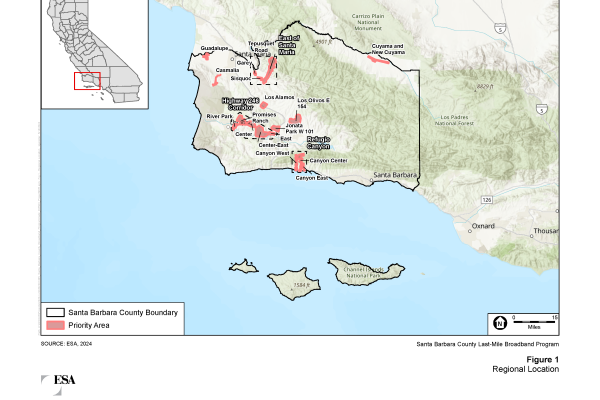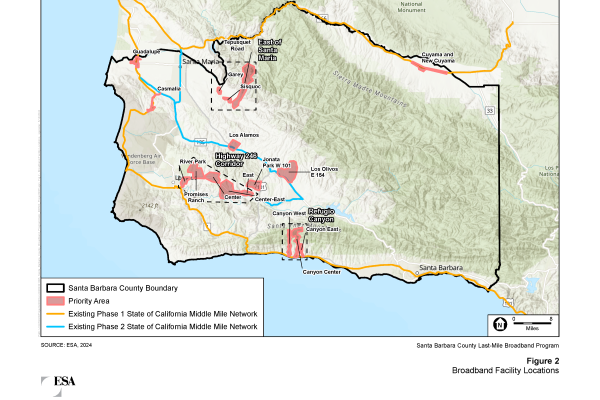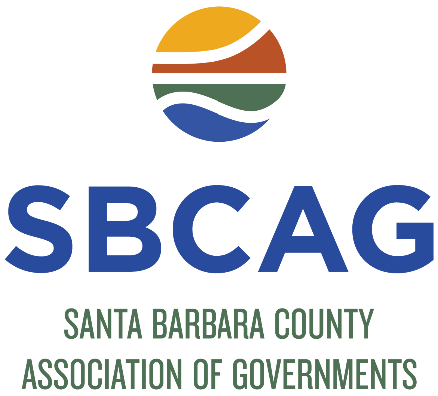Public Notice

Last-Mile Broadband Program Notice of Preparation for Environmental Impact Report
May 28, 2024
Notice is hereby given that the Santa Barbara County Association of Governments (SBCAG) will be the lead agency for the preparation of an Environmental Impact Report (EIR) for Santa Barbara County Last-Mile Broadband Program (“Broadband Program” or “Project”). Pursuant to section 15082 of the California Environmental Quality Act (CEQA), SBCAG is soliciting comments from all interested persons, responsible and trustee agencies and organizations concerned with the project as to the scope and content of the of the EIR and the environmental information to be analyzed in connection with the Project. The project description, location, environmental review requirements, and probable environmental issues to be addressed in the EIR is discussed below and linked as a resource. An Initial Study has been prepared for the Project in accordance with State CEQA Guidelines Section 15063(a) and is included in the resource list below.
SCOPING MEETING & PUBLIC WORKSHOP
SBCAG will host a virtual EIR Scoping Meeting/Public Workshop. The purpose of the meeting is to solicit input on the scope and content of the environmental analysis that will be included in the EIR, as well as to inform the public about the Project itself. The date, time and virtual location of the meeting is:
Thursday, June 6, 2024, from noon to 1 p.m. (public can log in starting at 11:45 a.m.)
Register to attend for Zoom meeting information: https://bit.ly/BroadbandEIR
For accommodations and Spanish-language interpretation, contact SBCAG 48 hours in advance at (805) 961-8900 or info@sbcag.org.
Mail comments to Fred Luna at SBCAG, 260 North San Antonio Road, Suite B, Santa Barbara, CA 93110, or e-mail comments to info@sbcag.org by 5 p.m. on July 1, 2024. For more information, please call 805-961-8900.
PROJECT DESCRIPTION AND SCOPE OF ENVIRONMENTAL ANALYSIS
Project Title
Santa Barbara County Last-Mile Broadband Program (“Project”)
Project Location
The area subject to future broadband facility installations under the proposed Project includes the entire County of Santa Barbara, since, with a few exceptions discussed below, the specific locations of future broadband facility installations are currently not known (see Figure 1, Regional Location, below). Such future installations would be proposed and implemented as part of the Broadband Program, where appropriate, in order to provide adequate high-speed broadband internet services to underserved and unserved communities as priority communities and funding sources are identified. A total of nine communities in the County have already been identified as “Priority Areas” under the Broadband Program. Figure 2, Broadband Facility Locations, below, provides a County-wide view of the Project Area, including the location of existing and/or approved middle-mile broadband facilities in the County, as well as the locations of all nine identified Priority Areas.
Project Description
The Project will include the installation of fiber optic cable in various locations throughout the County. High-level network designs for last-mile connections have been prepared for four Priority Areas. Funding for implementation, low-level design and construction, has been applied for but as of this NOP release, not yet been awarded. If awarded, SBCAG would have the Golden State Connect Authority (GSCA) undertake the work as they prepared the application and are a full-service broadband infrastructure provider, that would design, permit, construct, operate, and maintain all proposed broadband network facilities in perpetuity within the four Priority Areas. An additional five Priority Area locations are looking to be advanced for high-level network design through SBCAG’s agreement with GSCA.
In general, the new fiber optic lines would be installed underground following public or private roadways with the intention to minimize or avoid disturbance of roadway surfaces wherever feasible. However, it is possible some fiber optic lines could be installed directly under roadways in areas with limited shoulder space or where existing conduit under the road may be used, thus avoiding new surface disturbance. The Project also includes installation and construction activities within those areas where lateral lines are installed between public or private roadways and individual businesses or residences. Individual residence or business connections typically would be installed within previously disturbed and/or developed areas (e.g., adjacent to driveways or in landscaped areas), and generally would avoid drainages and sensitive habitats. Lateral alignments would typically follow other utility installations. Although not anticipated, where subsurface installation of fiber optic cable is infeasible, aerial installation along existing utility poles will be undertaken. GSCA’s methods of aerial installation will follow General Order 95 pole safety and loading requirements.
Components to be installed/constructed within the four Priority Areas include the following: broadband conduit (i.e., rigid casing to protect fiber optic cables from physical damage and the elements) with diameters between ¾-inch and 2 inches to be installed within road rights-of-way (ROWs); aboveground, prefabricated walk-in hut/shelters made of aggregate wall materials; small aboveground steel distribution cabinets/enclosures; distribution fiber, splice points, and drops; drop hubs; and small underground structures such as hand holes. Additional Project components that may be necessary to connect end-users to the middle-mile broadband network may include: utility poles with aerial fiber and connection points; underground fiber markers; and signage.
Once constructed, the broadband network components would generally operate passively, with only incidental maintenance typically consisting of weed abatement and periodic accessing of hand holes and splice cases from the ground surface along a given alignment.
Issues to be addressed by the EIR
The impact categories listed below have been preliminarily identified as anticipated issues to be addressed in the Program EIR.
- Air Quality
- Biological Resources
- Cultural Resources (including Paleontological Resources)
- Energy
- Greenhouse Gas Emissions/Climate Change
- Noise
- Tribal Cultural Resources
- Utilities and Service Systems (Electrical and Telecommunications Facilities)
As a Program EIR, the EIR will have three primary purposes: (1) to provide a broad overview of the potential environmental consequences of the implementation of the Project on a County-wide basis; (2) to serve as a mid-tier environmental document that will focus and streamline the subsequent project-level review of individual future projects that will be undertaken and in aggregate are referred to as the Project; and (3) to provide detailed project-level analysis of the nine Priority Area project locations that will be evaluated in the PEIR.




 Initial Study
Initial Study Video Recording – June 6, 2024 Scoping Meeting
Video Recording – June 6, 2024 Scoping Meeting
